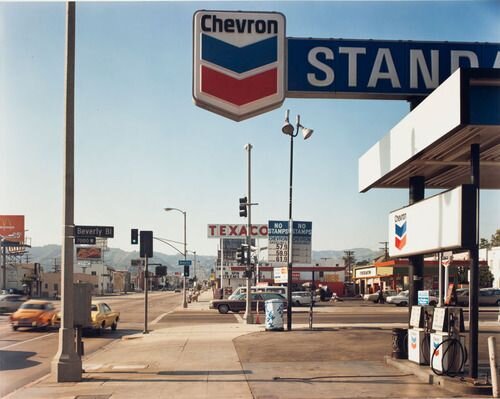New Topographics: Photographs of a Man-Altered Landscape opened 45 years ago, at the International Museum of Photography at George Eastman House in Rochester, New York. The show, curated by William Jenkins, pieced together the work of 8 American, and two German photographers. The exhibition eschewed the romanticised ‘idyllic’ view of the landscape that had been the norm for art photography up until that point. Instead, with the exception of the Bechers, the collection drew together unremarkable scenes of everyday America in an attempt to redefine beauty. Such was the paradigm shift in the notion of what photography was, that the show was largely disparaged by the critics of the day. With the benefit of time, we now understand the seismic impact that NT had within the art world and those ripples continue to inspire new generations of photographers and other artists to this day. 45 years later, to what extent is New Topographics still relevant in 2020 and is it time for a change around here?
Before we attempt to wrestle with the debate, a little more from my perspective. The key word for me when describing the original exhibition and subsequent movement is ‘deadpan’. A blank, expressionless gaze at the unexceptional. Are we vacant because of the disillusionment? A disappointment with humanities irreversible impact on the environment? Perhaps, but that is for the viewer to decide as the NT lens continues to record a poker-faced view of the world as it is. The pregnant-pause of the NT glare challenges us to stop and examine what the familiar means to us. By withholding any judgement, the space is set for us to survey our own personal relationship with the world around us, as well as ruminate over the countless controlling forces that shape our society.
Robert Adams - Mobile Homes
45 years later, can NT evolve to avoid stagnation? Perhaps after 45 years of an unresponsive stare, one could argue it is time for revolution. Indeed, individuals are beginning to produce heavily photoshopped montages of landscapes that don’t exist in reality, hanging the NT moniker on the work. Personally, I feel that Fake Topographics is a man-altered landscape gone too far. For me, the movement holds ethical hands with street photography. With the whole occupied world out there, surely there is more than ample material to capture without having to resort to make-believe? Having said that, I commend these efforts as simply the act of bringing ‘digital art’ into the niche field of NT re-tests its boundaries and challenges the status quo.
Conversely, 45 years on, does NT even need to evolve? Whilst the underlying ethos remains constant, the accompanying body of work has to move forward simply because the landscape in front of the photographer moves forward with it. In this context, New Topographics is forever a crusade for our current time and place. Further, when viewed in retrospect the topographical studies arguably increase in significance. Not only do they take on historical value, they also reveal a continual state of flux and the simultaneous stasis of humanity.
Stephen Shore - Beverly Boulevard and La Brea Avenue, Los Angeles, California,
June 21, 1975
I’m fully aware, that I’m probably being a little crusty with these outmoded views. Life moves on after all. Perhaps thats my point though, and our self-appointed job is to document that very process. Who knows, maybe one day we could collate these banal observations into some sort of living archive of the entire world as we know it. Indexed and dated, all ready to show the aliens when they land :) In some regards, we already have this - just search #newtopographics on Instagram or Google images. But I’m thinking more. More resolution, bigger, better, conceivably even with 3D rendering. Imagine the lovechild of Minority Report and VR. Pop on the headset and there you are, staring up at Stephen Shores Chevron sign. A swipe of the hand and you’re stood looking at Mobile Homes taken by Robert Adams. I’m probably sliding down a slightly surreal rabbit hole right now, but then I started the discussion about the relevance of New Topographics in 2020. Now that we’ve got that one out of the way, I’m looking to preserve the movement for another 45 years.


